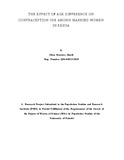| dc.description.abstract | African society has attached great importance to marriage anᄚci' family formation, because values and social mores favour the early marriage, child birth and members of society especially males favour to marry younger female. The pattern of marriage in which the age gap between the spouses for the favour of the husband is an important indicator to measure the status and position of women in the society and can be confirmed that the i~crcasing age gap between spouses to the favour of the husband means that he is more dominant on family decision making. Age difference between couple could also be an indicator of a woman's autonomy. It also determines who a couple interact with each other due to generation gap. The wife being junior to her husband and a woman could be treated as a subordinate. This could impede a woman from making vital decisions like contraceptive use. The Kenyan government has made efforts to increase contraception prevalence even before Kenya's independence. As a result, knowledge on contraception is very high in Kenya but its use is less than average the number of married women. Unmet need is still an issue its satisfaction could avert a significant number of maternal deaths and child deaths. It has been noted that young women are the ones who suffer most from unmet needs. Gender inequality leads to a woman having no say in decision making, including use of contraceptives.
The main purpose of this study is to access the effect of age difference on contraception usc among married women. This study concentrates on married women since several studies have been done on this but concentrate on the adolescents. To be able to achieve this KDHS women's data was used. The total number of married women was 4682 of whom 1,672 used contraceptives. The conceptual frame work used was adopted from Mahidul et ai, since it illustrates the main proximate determinants of contraception usc. Univariate, bivariate and Multivariate analysis were used. Descriptive statistics generated showed the distribution of women by their background characteristics. Cross tabulations were used to show significant relationships that existed between each of the independent variables and the dependent variable. Chi-square was used to measure associations. Multivariate
logistic regression then was used. The bivariate analysis indicated that there was a significant relationship between woman's age, education, religion, work status, household wealth, place of residence, status of union, type of union, number of living children, future fertility intentions, her partner's fertility intentions, her partner's education level and her partner's age, age difference between the spouses and contraception use. When spousal age difference was examined on its own, it had a statistical significant association with contraception use. On introduction of the woman's characteristics, a reverse was observed. This could be attributed to the girl- child and woman empowerment. The government should therefore accelerate these programs, since they are seen to have positive results as far as contraceptive use is concern. | en_US |

